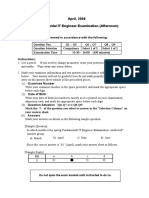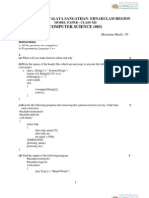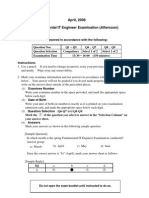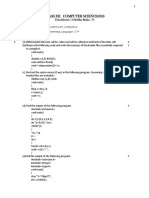–3– M15/4/COMSC/SP1/ENG/TZ0/XX
Section B
Answer all questions.
8. An insurance company holds a large database of information about its customers, including
the date of their next payment.
Once a month the database is searched to compile the following lists:
• list 1: customers whose next payment date will be within the next 30 days
• list 2: customers whose payment date has passed by more than 14 days but less than,
or equal to, 30 days
• list 3: customers whose payment date has passed by more than 30 days.
Customers who are in list 3 are flagged for deletion.
(a) Construct an algorithm to illustrate the monthly process described above.� [6]
After the lists have been compiled, the following messages are sent out to customers.
• A reminder is sent to customers in list 1.
• A warning that payments are more than 14 days overdue is sent to customers in list 2.
• A cancellation of contract is sent to customers in list 3.
(b) Explain how the lists could be used to merge the data from the database with a
word processor to create these messages automatically for sending either by post or
by email.� [4]
(c) Outline the consequences of data loss to customers and to the company. � [2]
(d) Describe one method that the company could use to prevent data loss.� [3]
Turn over
� –4– M15/4/COMSC/SP1/ENG/TZ0/XX
9. Six lawyers and one secretary work together in the same building and are connected via a
LAN to a central server. Each has their own workstation.
(a) Outline the concept of the Open Systems Interconnection (OSI) model in
communication across a network.� [3]
(b) Outline, with an example, the function of protocols.� [3]
The LAN has one server, which is connected to the internet. The workstations are connected
to the server by cable. There is also a wireless connection.
(c) Outline one advantage and one disadvantage of allowing wireless access to the server.� [4]
Print jobs are sent to a shared printer from all workstations and added to the print queue
in the order in which they are sent. A priority is given to each job based on the number of
pages requested.
• The highest priority (1) is given to jobs with 1–3 pages.
• The lowest priority (4) is given to jobs with more than 50 pages.
The jobs sent to the printer are held in a collection of objects. Each object includes the
priority that has been given and the time it was sent to be printed.
If any job has been waiting more than 10 minutes it is moved to the front of the queue and is
the next to be printed.
(d) Outline the steps needed to search the collection and return the next job to be printed.� [5]
10. (a) Identify two differences and two similarities between a bubble sort and a selection sort
when sorting an array of 10 elements.� [4]
A cycling tour lasts for 15 days. The total time for each competitor is recorded in a
one-dimensional array, TIMES[]. After each day’s race, the array entry for each competitor
is increased by their time for that day.
There are 150 competitors and the 10 fastest times are transferred to the array FASTEST[]
and displayed on a screen each day.
(b) Explain why a selection sort would be more efficient than a bubble sort in this case.� [2]
(c) Construct an algorithm to transfer the 10 fastest times from the array TIMES[] to the
array FASTEST[]. Assume that the array TIMES[] is not sorted.� [6]
The race organizers need to display the names of the 10 fastest competitors, as well as
their times, on the screen. There is another array, NAMES[], which contains the names of
all competitors in the same order as their times in TIMES[] (for example, NAMES[5] and
TIMES[5] are the name and time of the same competitor).
(d) Compare the use of two arrays, to hold the competitor’s times and names, with the use
of objects.� [3]


































































































